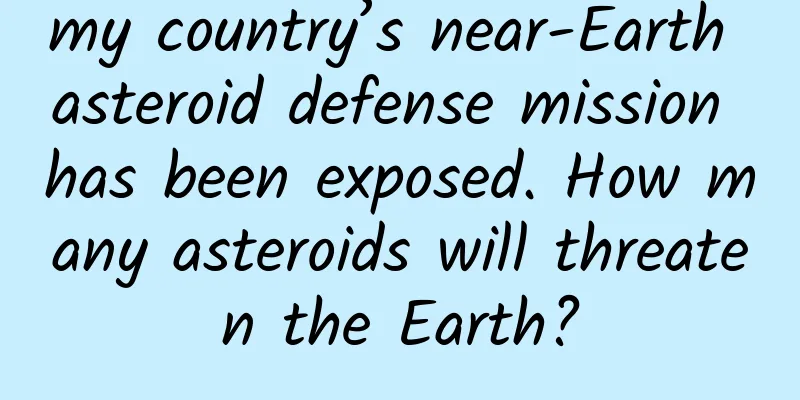my country’s near-Earth asteroid defense mission has been exposed. How many asteroids will threaten the Earth?

|
Recently, Wu Weiren, an academician of the Chinese Academy of Engineering, revealed at the annual meeting of the China Association for Science and Technology that China will implement a near-Earth asteroid defense mission in the next decade. What is an asteroid? How big a threat is it to the Earth? How to defend against impact? Written by reporter Chen Yongjie Photo and text editor Chen Yongjie Image source/Visual China Reviewers: Jiao Weixin (Professor, School of Earth and Space Sciences, Peking University) On October 22, Wu Weiren, director and chief scientist of the China Deep Space Exploration Laboratory and academician of the Chinese Academy of Engineering, introduced the country's space exploration plan for the next 15 years at the annual meeting of the China Association for Science and Technology. The plan includes a manned lunar landing around 2030 and the first "near-Earth asteroid defense mission" in the next 10 years. ▲Wu Weiren, director and chief scientist of China's Deep Space Exploration Laboratory and academician of the Chinese Academy of Engineering, revealed at the 25th China Association for Science and Technology Annual Conference that the first "near-Earth asteroid defense mission" will be launched in the next 10 years (Photo source/Visual China) Academician Wu Weiren also introduced in detail the specific approach of the near-Earth asteroid defense mission, aiming at a small celestial body tens of millions of kilometers away from the Earth and tens of meters in size, and then launching an impactor 10 million kilometers away from it to change its orbit and then evaluate the effect. The purpose of this mission is to verify the ability to prevent asteroids from hitting the Earth and achieve the goal of "accurately hitting, pushing, measuring, and explaining". What is an asteroid? How much of a threat does an asteroid pose to the Earth? How to defend against asteroid impacts? There are more than 2,000 known asteroids that pose a threat to Earth. How is an asteroid defined? NASA defines it as: the lower limit is 1 meter in diameter, and some believe it is 10 meters in diameter. Why is it defined as 10 meters? Jiao Weixin, a professor at the School of Earth and Space Sciences of Peking University, explained that asteroids with a diameter of more than 10 meters will not burn up when they enter the Earth's atmosphere, and at least some meteoroids will fall on the Earth's surface. ▲Image of an asteroid burning up after entering the Earth's atmosphere (Photo source: Visual China) Asteroids can be divided into three types according to their location: near-Earth asteroids orbiting near the Earth, main-belt asteroids distributed between Mars and Jupiter, and Trojan asteroids. ▲Based on their location, asteroids are divided into near-Earth asteroids, main-belt asteroids, and Trojan asteroids (Image source: Jiao Weixin) As near-Earth asteroids, those that meet the perihelion (the closest distance between the Earth and the Sun) of less than 1.3AU (AU is an astronomical unit, the average distance between the Earth and the Sun is set at 1AU, which is approximately equal to 149.6 million kilometers) are near-Earth asteroids. Near-Earth asteroids are divided into Amor asteroids, Apollo asteroids, Atan asteroids and Attila asteroids according to their different locations. With the improvement of the performance of ground-based telescopes, asteroids several meters in size can now be seen. As of 2021, scientists have discovered 27,000 near-Earth asteroids. ▲Near-Earth asteroids that have been discovered (Photo source: Jiao Weixin) "The study of near-Earth asteroids is of great significance, mainly to avoid large collisions between celestial bodies," Jiao Weixin explained. Asteroids that are potentially dangerous to the Earth are scientifically represented by the symbol PHA. As of February 2, 2021, scientists have discovered a total of 2,216 PHAs, which means that we know of more than 2,000 asteroids that are potentially threatening to the Earth. ▲The minimum orbital rendezvous distance of the Earth (Photo source: Jiao Weixin) But will these more than 2,000 asteroids definitely hit the Earth? Not necessarily. "We are just saying that these celestial bodies are more dangerous to hit the Earth. In addition, because asteroids are too small, their orbits are easily affected by large celestial bodies. Scientists predict that there will be no disaster to the Earth, but after being affected by other celestial bodies, they may get closer and closer. Some of them now seem to be potentially dangerous to the Earth, but due to the influence of other factors, they are getting farther and farther away from us, so this data is developing dynamically," Jiao Weixin explained. Asteroid impacts on Earth are not groundless "Asteroid impacts are not groundless," Jiao Weixin stressed. On February 15, 2013, an asteroid impact occurred in Chelyabinsk, Russia. When the asteroid entered the atmosphere, it left a trail about 10 kilometers long in the sky. The main fragments of the asteroid hit Lake Chebarkul. 1,491 people were injured in the incident. ▲On February 15, 2013, an asteroid impact occurred in Chelyabinsk, Russia (Photo source: Jiao Weixin) In history, the Earth has experienced catastrophes, and nearly 200 meteorite craters have been confirmed. Some meteorite craters can no longer be identified due to changes in the Earth and river channels. The Tunguska explosion occurred at 7:17 a.m. on June 30, 1908 over what is now Siberia, Russia. At the time, it was estimated that the explosion was equivalent to 20 million tons of TNT, and more than 80 million trees within an area of more than 2,150 square kilometers were burned and fell. The current consensus is that an asteroid with a diameter of approximately 60 to 190 meters exploded due to intense friction with the atmosphere at an altitude of about 6 to 10 kilometers above the ground, resulting in uneven heating and the destruction of the entire Tunguska forest. ▲Imaginary picture of the Tunguska explosion (Photo source: Jiao Weixin) The danger of asteroids hitting the Earth still exists, mainly for three reasons: First, a large number of celestial bodies have not yet been discovered. The number we have observed is only about 10%. There are still many celestial bodies that have not been discovered. Are these celestial bodies dangerous to hit the Earth? We don’t know much about them yet. In mid-August 2020, a near-Earth asteroid the size of an SUV, numbered "2020 QG", passed by the Earth at a close distance. Just as it was about to leave, it was detected by a NASA probe, but this was 6 hours later. The second reason is the sudden arrival of uninvited guests, including short-period comets that accidentally enter the inner solar system, making it even more difficult for humans to determine their orbits. For example, Comet Shoemaker-Levy 9 broke into 21 small fragments on July 8, 1994 due to the strong gravity of Jupiter, and hit Jupiter's southern hemisphere at a speed of 210,000 kilometers per hour on July 16, 1994. Fragment G has the greatest power, reaching 6 megatons of TNT, and its equivalent The "scar" caused is expected to be larger than the diameter of the earth. ▲Comet Shoemaker-Levy 9 hits Jupiter (Photo credit: Jiao Weixin) The impact of Comet Shoemaker-Levy 9 on Jupiter highlights the role of Jupiter as a "space vacuum cleaner" in the solar system. Its strong gravity can suck up many comets and asteroids, and the probability of Jupiter being hit by a comet is 2,000 to 8,000 times that of the Earth. The Earth is in a very advantageous position, and with the protection of Jupiter, the Earth is a habitable planet. The third reason is the Yakovsky effect, which is a small force on asteroids when they absorb sunlight and release heat. For example, according to observations of asteroid 6489 Golevka, its position moved 15 kilometers more than expected between 1991 and 2003. ▲Schematic diagram of the Yakovsky effect (Photo source: Jiao Weixin) A variety of methods can eliminate the threat of asteroids What is the risk of an asteroid hitting the Earth? The smaller the size, the greater the probability of an asteroid hitting the Earth. According to statistical laws, if the diameter is less than 30 meters, it will break up in the upper atmosphere and generally will not cause casualties on the ground. If the diameter is greater than 30 meters and less than 100 meters, such a celestial body will burn and break up in the lower atmosphere, which will have a local impact on the ground. Asteroids with a diameter greater than 100 meters and less than 300 meters can directly impact the Earth's surface, creating craters with a diameter of several kilometers. The resulting dust blanket will affect an area with a diameter of 10 kilometers. Asteroids with a diameter greater than 300 meters and less than 600 meters will cause the smallest level of global disaster, causing the deaths of about 500,000 people, with an interval of 25,000 years. An asteroid with a diameter greater than 600 meters and less than 1,000 meters will cause a moderate global disaster, with a death toll of about 5 million and a time interval of 70,000 years. Asteroids with a diameter greater than 1 km and less than 5 km are large enough to cause global damage, killing more than 1 billion people, and occur approximately once every few million years. Jiao Weixin said that there are ten major measures for humans to avoid asteroid impacts. The first is to strengthen observation and early prediction to understand its orbit. The second is to use dynamic impact to deflect the orbit. The third is to install rockets to change the orbit. The fourth is solar sail propulsion. The fifth is gravity tractor. The sixth is nuclear explosion near the asteroid. The seventh is nuclear explosion inside the asteroid. The eighth is mass projector. The ninth is laser ablation. The tenth is to use solar energy to vaporize matter to generate thrust. Among them, the plan of launching a probe for dynamic impact has already been implemented. In November 2021, the United States launched two satellites (DART) to a relatively close celestial body, impacting a large asteroid with a diameter of about 780 meters and a "small satellite" with a diameter of 160 meters. ▲DART asteroid redirection test mission (Photo source/Jiao Weixin) As early as January 1996, the Near-Earth Asteroid Dating probe was successfully launched into space. Its mission was to orbit the asteroid Eros and land on it to explore the secrets of the asteroid. During its flight to the asteroid, the probe sent back 160,000 photos and a large amount of precious materials to Earth, providing scientists with many important references for future exploration of other asteroids and comets. Finally, after flying over a distance of 3.2 billion kilometers, the probe successfully entered the orbit of the asteroid Eros and began exploration. ▲On February 12, 2001, the U.S. "Near-Earth Asteroid Dating" unmanned probe successfully landed on the "Eros" asteroid, achieving the first encounter between a probe and an asteroid in history (Photo source/NASA) In 2014, Japan launched the Hayabusa 2 asteroid probe, which used a contact-and-leave method to collect asteroid samples and return them to Earth. ▲Japan launches the asteroid probe Hayabusa 2 (Photo source: Jiao Weixin) On China's Space Day on April 24 this year, Wu Yanhua, deputy director of the China National Space Administration, disclosed to the outside world for the first time that China must first improve the establishment of ground-based and space-based monitoring and early warning systems for asteroids. Not only must they be catalogued, but the key is to analyze and determine which ones are of the highest risk; technical research and efforts must be made to determine whether it is possible to eliminate these threats. While improving its asteroid detection capabilities, China will also start to build a near-Earth asteroid defense system. Wu Yanhua revealed that China will strive to conduct a close observation of a threatening asteroid at the end of the 14th Five-Year Plan or in 2025 or 2026, implement a nearby impact, and conduct technical experiments on changing its orbit, so as to make new contributions to China's response to the threat of asteroids and other extraterrestrial bodies to the Earth's home in the future. |
Recommend
The correct way to use the prompt box in iOS9
[[154064]] In the process of upgrading from iOS8 ...
What do astronauts do when they go out for a walk?
The recent "Feel Good" team Going out f...
How to build a user “retention” system?
In order to attract more users, many companies ar...
"Laso" has made new discoveries! The world's first accurate observation of the entire afterglow of a once-in-a-millennium gamma-ray burst
Produced by: Science Popularization China Author:...
Live streaming and street stall economy
Operator thinking is a complete thinking framewor...
6 promotion skills for self-media operation, telling you how to do a good job of promotion!
For operations personnel, whether you are doing u...
5 ways to express your creative advertising skills!
In 2014, Tim Collins published " 100 ways to...
There is a Block called Callback, and there is a Callback called CompletionHandler
[Introduction] The APIs of the iOS 10 push part u...
Tumen SEO Training: How to analyze competitors' websites and where to start?
Competitors stand, only by standing on the should...
WM Motor EX5 caught fire in Wenzhou: The whole vehicle burned but no one was injured
[NetEase Intelligence News, September 23] Today, ...
In 2020, move from KOL marketing to influencer marketing!
Since the birth of social media, "influencer...
Wang Xun's article master class teaches you different ways to write articles
Wang Xun's article master class teaches you d...
Say goodbye to rejection, how to improve iOS review pass rate (Part 1)
iOS review has always been a huge challenge for e...
Why does the subway stop so accurately every time? How does the video outside the window move?
Source: A student tyrant (ID: bajie203) This arti...
Is there any effect on eating bull whip on the same day? How long does it take to react after eating bullwhip?
Bullwhip is a very good aphrodisiac and kidney-to...









